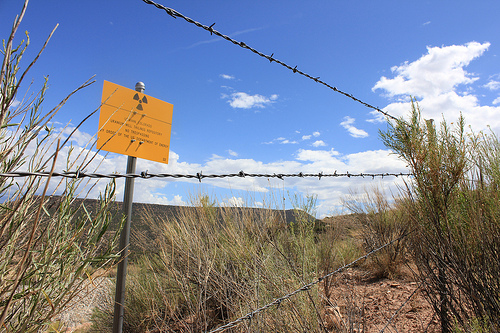In Colorado and Virginia residents debate whether proposed uranium mills will help or hinder their economies.
by Rose Jenkins
To reach the place where an entire town had been dismantled and buried in a Superfund cleanup, I traveled through coils of red rock canyons—sheer cliffs that enclosed the Dolores and San Miguel Rivers in southwest Colorado. My guide, Jennifer Thurston, who directs of a mining watchdog group called INFORM Colorado, told me that the tops of these mesas are dotted with old uranium mines—mines that once fed ore to the mill at Uravan.
Rough gravel roads took us to the spot on the San Miguel River where the town of Uravan used to be, the the U.S. Environmental Protection Agency (EPA) and state of Colorado determined the town to be so contaminated that it was unsafe for people to live there. The town, which was home to over 600 people, was evacuated as part of a Superfund cleanup spanning 1986 to 2008. Then every structure—the mill, schools, houses, playgrounds—was torn down, shredded, and buried. Today, the site is off-limits, barricaded by barbed wire fences and yellow signs that warn of radioactive exposure.
Uravan was a company town, named for two minerals that are found together in the ore here—uranium, which is used to make nuclear fuel, and vanadium, which is used to harden steel. Because nearly every family that lived in the town worked at the mines or the mill, nearly all of the residents were struck a personal blow by the epidemic of lung cancer that took place among the miners.
During the last uranium boom—roughly from the 1940s through the 1970s—miners labored in poorly ventilated tunnels that trapped radon from the radioactive ore and diesel exhaust from their machinery. In addition, cigarette smoking in the mine shafts was widespread. Many of the men who worked in these conditions died of lung disease, and others struggle with it still.
But when I asked Bill Chadd, who mined uranium for twelve years, lived in Uravan for ten, and suffers from lung disease, if he thought that a proposed new uranium mill would be good for the area, he said, “You bet.”
Over breakfast in the lobby of The Ray Motel in Naturita, Colo., near the former town of Uravan, he told me, “It would open up about 300 jobs.”
Energy Fuels Inc., has proposed to build a new mill, the Piñon Ridge Mill, less than 10 miles from Uravan. On the other side of the country, a company called Virginia Uranium, LLC proposes to mine and mill uranium in Virginia—my home state.
Uranium has never been extracted in Virginia, but communities in the West have a long history with uranium mining. I have been researching their stories, so Virginians can learn from their experience.
In southwest Colorado I found that the people whose lives were most intertwined with the uranium industry—those who had benefited most directly from its jobs and suffered most intensely from its mistakes—were most ready to give it another go.
Other people, who live and work at a greater remove from the industry, in towns that are prospering without it, see the Piñon Ridge Mill as unacceptably risky. They consider the proposed mill an environmental and public health threat, and they also think that it could derail economic growth in the region. Thurston, who lives in Telluride, Colo., some 50 miles from the Piñon Ridge site, told me, “A uranium mill, in reality, is a radioactive waste dump. The stigma of having radioactive facilities in your community makes it more difficult to attract people.” Read more.



